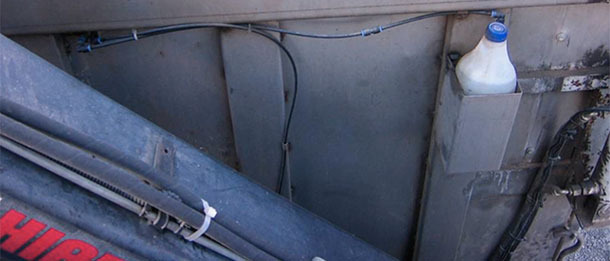Paper
Further assessment of houseflies (Musca domestica) as vectors for the mechanical transport and transmission of porcine reproductive and respiratory syndrome virus under field conditions. Pitkin A, Deen J, Otake S, Moon, R, Dee S. Can J Vet Res. 2009 73: 91-96

Paper summary
What are they studying?
PRRSV can be transmitted from infected pigs, contaminated semen, fomites, people, transport vehicles, and aerosols. In regard to insects, mosquitoes (Aedes vexans) and houseflies (Musca domestica) could serve as mechanical vectors of PRRSV, since the virus does not replicate inside these species, making it impossible for them to act as biological vectors.
The purpose of this study was to evaluate the role of houseflies in the transport and transmission of PRRSV between farms under controlled field conditions.
How do they study it?
During a 16-week period, 7 two-week replicates were conducted in a research farm separated from other swine farms by 16 km.
Barn A housed 300 head of grow-finish pigs (100 of these pigs were intra-nasally inoculated with 2 mL of PRRSV) and several containers with pupae of houseflies were placed on the top of each concrete pen divider (a total of 200,000 pupae per replicate) to allow adult flies to contact pigs.
Barn B was naturally ventilated and had solid concrete flooring; it housed 20 PRRSV-naïve, 25-kg pigs at 120m from A. Serum from all 20 pigs on barn B was collected on days 2, 5, 7, 9, and 12 of each replicate.
Barn B was always visited before A. Personnel (3 designated people) wore farm-specific boots, coveralls, and gloves upon entry to the pens in facility A and in facility B.
Fly traps were used in both barns. Flies were counted and placed in a labeled plastic bag. Flies were then pooled by collection day with 30 flies included per pool. Swine bioassays were performed to see if infectious PRRSV was present in fly samples collected from barn B.
Also, staff hands, boots and coveralls were swabbed, and air samples collected, and all tested for the presence of PRRSV RNA.
What are the results?
There was extensive contact between flies and pigs. 49 fly pools (a total of 1,459 flies) were tested from barn A. Sixteen of these pools (a total of 479 flies) were PCR-positive. In barn B, 12 pools (365 flies) were tested; 3 were found positive and were able to infect pigs by swine bioassay after the experimental phase concluded.
Transport of PRRSV RNA from facility A to facility B in 2 of 7 replicates was detected. PRRSV RNA and infectious virus was detected in fly pools from facility B and from infected animals housed in that barn in the same two replicates.
PRRSV RNA was not detected in any of the air samples (n = 70) or the swabs from fomites and personnel (n = 1176).
Nevertheless, infection was observed in pigs in two of the replicates in barn B, most likely due to houseflies, based on the high degree of homology between swine and insect samples collected in facilities A and B.
What conclusions are drawn from this work?
Under the right conditions houseflies can get PRRSV from infected pigs, harbour the virus in a viable state and transfer it to different barns within a farm facility or to other commercial swine farms.
Even though transmission of the virus by insects to naïve pigs is most likely a quite infrequent event —since it depends on a great number of factors—, it has nonetheless been proven to be possible. It is not known whether transmission of PRRSV from flies to pigs can occur beyond 120 m.
Houseflies have been proved to be a risk factor for new PRRSv infections and, therefore, producers and veterinarians should implement valid interventions to control insects in pig barns.
|
When setting biosecurity protocols on farms we always introduce -after discussing fences, protocols for visitors and materials entry, and safety requirements for loading / unloading of animals-, comments about rodents, birds and insects control. The latter are present in almost all biosecurity plans, but how often do we consider them a real risk? If we consider the results of the study conducted at the University of Minnesota, the possibility that flies can act as carriers of the PRRS virus is a real risk, at least in short distances (120 m.) When assessing control measures against viral circulation in a farm, insect -and particularly flies- control, must always be taken into account. If the fly population is not under control, all biosecurity measures between batches already discussed in previous articles -prevention of movements of animals between batches, change of clothes, shoes, hand washing and batch-specific materials- will be useless. Fly control on farms must not only be based on the regular use of insecticides, but also on avoiding the ideal conditions for reproduction. The latter is relatively simple in the case of the housefly, because as long as we maintain manure pits in a relatively liquid state, without surface crusts, the larval stages cannot develop easily, thus reducing the fly population.
However, when the real possibility of infection between farms is assessed, flies are never seen as a real risk, unless we're talking about very high-density areas with very little distance between farms. As documented in the article, flies could travel distances of up to 2.4 km, but what happens when they are caught inside a vehicle? This may be the case of carcass collection lorries. When picking up the carcasses, flies are also caught and, in some cases, may be carried up to a few tens of kilometres. Avoiding the capture of flies by carcass collection lorries is difficult, if not impossible, but the use of insecticides on the inside of the container once it is closed (see detail of a disinsection system in the picture) would eliminate them, thus preventing the risk they pose. This method is already used by some of the collection companies and should be compulsory in all cases. |



















